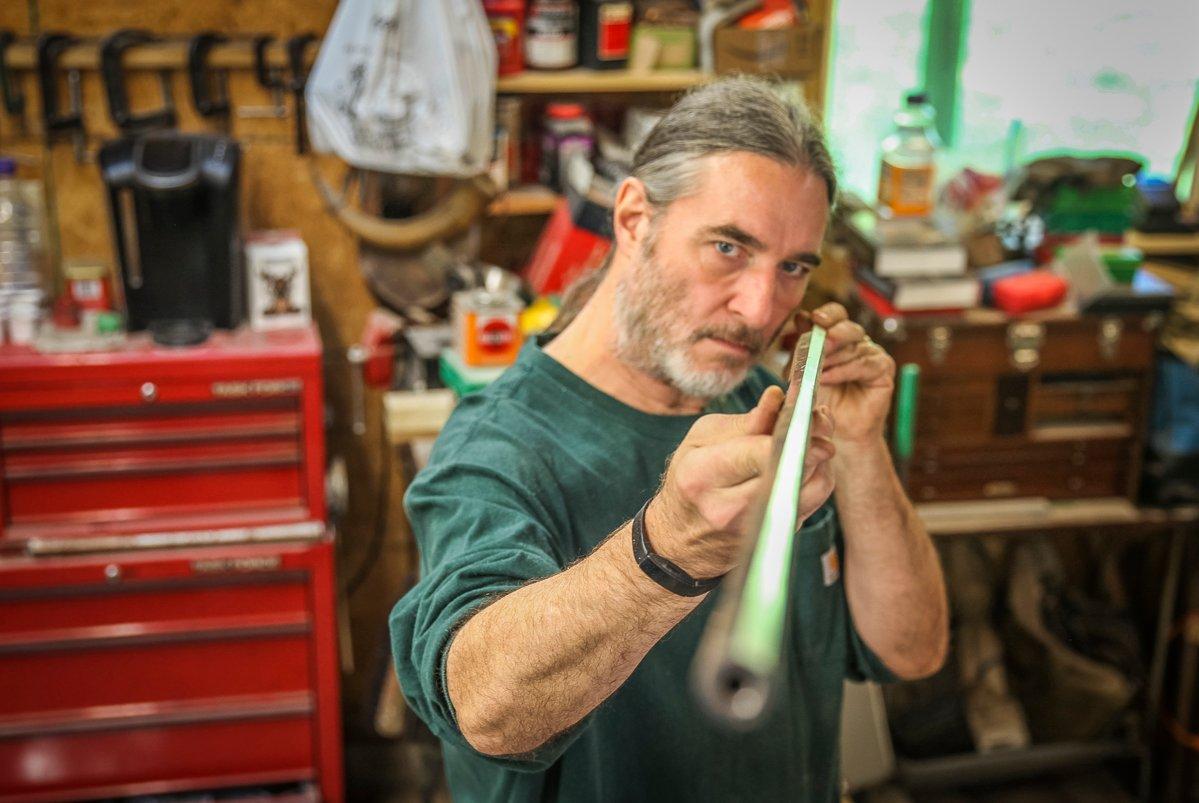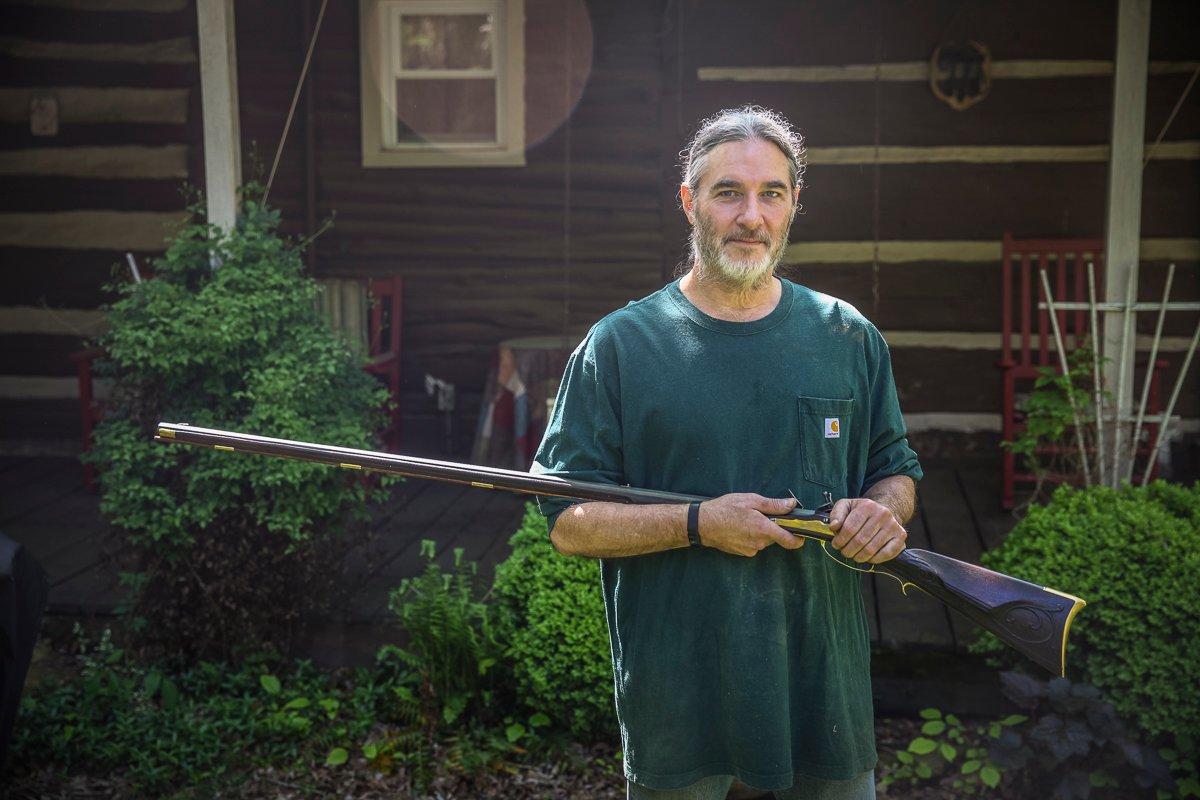A Kentucky gunsmith is faithful to the traditions of one of the enduring icons of the American frontier
Being an old-fashioned sort of guy, Mike Miller doesn't get into discussions about the best centerfire deer cartridges or if a particular model of shotgun is better than another. But he'll talk your leg off about why early American gunmakers usually chose maple rather than walnut for their gun stocks, or the perfect barrel length for a Kentucky rifle.
Which is what he's expounding on this day as he putters around his workshop. Selecting a gun barrel from a stack of octagonal barrels leaning beside his workbench, he upturns it toward the window light, peers into the muzzle, and studies the spiraled rifling. There's really nothing to see, but such cursory inspections give Miller a break from the more mundane chores of making muzzleloaders from scratch. He returns the barrel to its cradle against the wall, where it rejoins several others of various calibers that are waiting their turn.
It starts with the barrel. A muzzleloader is built around the barrel, so I don't scrimp on this most important part, he says as he returns to his chair at the workbench. I pick out a barrel that was made from one of a very few quality American barrel makers. I do the same with the other components. I give a gun as much attention to detail as a gunmaker of the 1700s might give it. I make a gun that a man could depend on to save his life, because that's exactly what muzzleloaders were called on to do back then.
Nowadays, of course, the owners of Miller's reproduction muzzleloaders aren't as concerned with survival as with how well their rifles show in reenactments and hunting camps. In that respect, Miller has been as successful as some of the better-known gunmakers of a bygone era. Though Miller's flintlocks are never used to fight off Shawnee or redcoats, or to travel with their owners on long hunts into the high lonesome, they're still a hit with modern blackpowder enthusiasts who feel the frontier past's strong tug.
Miller feeds their dreams because he shares them. He became a full-time muzzleloader handcrafter in 2003 after he retired from the police department in Paducah, Ky. While still in high school, he developed a talent for making rifles that any 18th century Pennsylvania gunsmith would appreciate. Miller is considered one of the best in the gunmaking business and his muzzleloaders - mostly flintlocks with an occasional caplock - range from .40- to .54-caliber with a lot of .50-caliber models in between. His rifles fetch four-figure sums and he averages about 15 annually. The waiting list for one of his creations is a couple of years long.
(Don't Miss: Create a Long Range Muzzleloader)
Back to the Start
Hershel House, Wallace Gusler, Ron Ehlert — names bound to be mentioned wherever flintlock makers gather to compare notes and rifle styles — were among the artisans whose work influenced Miller's work. He made his first rifle, a Hawken, from a CVA kit when he was 12 years old. Three years later, he graduated to his first stick or long rifle. The barrel and lock were purchased from Dixie Gun Works, and his grandfather's sawmill provided the walnut stock.
I built a number of rifles over the years, and learned a lot by watching how-to videos and then trying out some of the things that others were doing, says Miller. He not only watched videos, but eventually he began to appear in them, most notably the American Pioneer Video series.
Really, my whole outlook changed in the early '90s when I met Bill Nagel at a Paducah shooting range, he adds. Bill was a local gunmaker at the time and after I showed him some of my guns, he invited me to his shop. He showed me a couple of rifles that he had made, and a couple that Ron Ehlert had made, and said 'this is what they're supposed to look like.' What I saw made me want to go home and burn my rifles.
Five years ago, Miller, 58, and his wife Kim moved to Edmonton, Ky., which is on the western flank of the Cumberland Mountains in the south-central part of the state. Their two-bedroom log cabin was built in 1837 and is nestled in a swath of mixed forest and farmland roughly equidistant between Lake Cumberland and Barren River Lake. Once the homeland of backwoodsmen, now it's a wilderness of the imagination for those like Miller who appreciate the historic significance of the American frontier. He also enjoys hunting with his muzzleloaders, and the surrounding woods abound with squirrels, deer, and turkeys.
(Don't Miss: Don't Be a Shooting Range Jerk)
Locks, Stocks, and Barrels
By the looks of Miller's shop, he has the makings for enough flintlocks to outfit a company of minutemen. Beside the boxes of barrels leaning against one wall, dozens of maple blanks occupy another wall and corner. Miller's workbench — illuminated by a window and overhead fluorescent light — is a jumbled clutter of files, hammers, woodcarving tools, gravers, screwdrivers, flintlocks and ramrods and assorted gun parts, rifle drawings, rags and other flotsam and jetsam whose purpose is a mystery to everyone except the person who put it there - or maybe not.
A vise with leather-lined jaws clamps the musket stock he's currently making. No hurry; building a muzzleloader is a quiet, slow process. Marrying wood and metal can't be rushed. Focus is essential. Neither Miller nor 17-year-old Malchiah Pifer, the local lad who helps him, have much to say as they go about the painstaking work of converting chunks of maple, steel, and brass parts into something a long hunter would be proud to carry. Miller is patiently chiseling away at a length of curly maple that will become the stock for a Kentucky long rifle, while Pifer is etching a name onto the barrel of another muzzleloader. They pause occasionally to wipe down their handiwork, part of the process of coaxing perfection from rough-hewn metal or wood.
Three years ago, Pifer's father took him to shoot one of Miller's flintlocks and the youngster was mesmerized by the guns and the long-gone culture they represent. He wound up apprenticing for Miller, soaking up as much as he could by watching the master, and then started turning out his own creations. In 2020 one of Pifer's rifles, a .45 caliber model, was chosen for a special fundraising raffle by the National Muzzle Loaders Rifle Association.
(Don't Miss: The Right Way to Clean and Store Your Hunting Rifle)
Flintlocks As Art
There's a forge behind Miller's shop, though he seldom uses it for anything except casting the small pieces of hardware essential to flintlocks. He makes anywhere from a few guns of various calibers to more than a dozen a year, depending on demand and his sense of how many is too many. Putting a rifle together isn't nearly as difficult as adding the proper touches. Fit and finish get equal billing at Miller's shop, and his attention to detail usually exceeds the owner's expectations.
I'll make about a gun a month, he reckons. I'm noticing as I put on more years that I might not make even one a month. One year not so long ago I made 28. So I can make guns pretty fast if I want to, but then I start getting burned out. This is definitely a job that I like, but if I'm having to work 10 or 12 hours a day putting guns together, it's not going to stay enjoyable.
Ultimately, his creations will grace the homes of gun connoisseurs who want more than store-bought imitations. By and large his muzzleloaders are styled after the English, German, or French rifles carried by frontiersmen. They were notable for their simplicity and dependability: few moving parts, but virtually unbreakable. There was a time when those who carried them had to depend on them for their lives and the lives of their families. Miller's renditions are faithful to that purpose, but he also celebrates their utilitarian genesis through the artfulness with which he imbues them.
Why does somebody want a custom-made flintlock nowadays? Typically, somebody who orders a rifle from Miller lands in one of three groups. First, there are the sticklers for authenticity who want everything about a long rifle to be historically accurate. Some might be re-enactors who rendezvous occasionally to commemorate events that took place in America 's infancy and act out their various roles. They dress up in the proper regalia right down to the historically correct shoe buckles.
These 'living history' people buy at least 60 percent of my guns, Miller says. Then there are those who simply like the looks of the guns and have the money to spend, which is a few thousand dollars. Some of these might be hunters who just get a kick out of hunting with the same sort of firepower as their forebears. The third group is identified by Miller as straight-up shooters who go out and shoot at targets with four- or five-thousand-dollar guns for trophies and prestige.
Miller can accept any rationale including ars gratia artis: art for art's sake. Whatever the purpose, he makes guns because he's very good at it, which suggests that is mainly what he's supposed to be doing. All other motives aside, it's his turn to produce guns sure to be a topic of conversation wherever tomorrow's gunmakers and gun fanciers gather. It was all decided long ago when he saw the work of artisan gunmakers and decided he wanted to be one of them. In the process, he's passing along some of those traditions associated with carving a nation out of raw material.
In the deep woods of the Cumberland piedmont, where timeless streams trickle down from the hills and the trees rustle with ancient echoes, Miller has his own role to play.
(Don't Miss: Chad Schearer's Top 7 Tips on Black-Powder Rifle Shooting)












